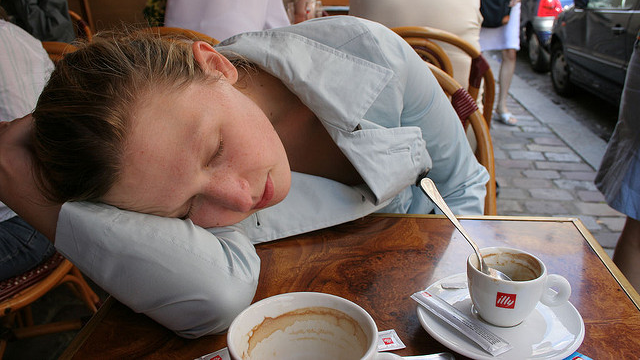Caffeine is a wonderful tool to combat our natural energy swings during the day. However, we get less and less of the cognitive benefits of drinking coffee over time, thanks to caffeine tolerance. One strategy for maximum focus is to switch up your coffee routine and combine it with the restorative powers of a nap.
Arvind Narayana, a computer science professor at Princeton and affiliate scholar at Stanford Law School, explains what’s at play here: Caffeine decreases the activity of adenosine, a sleep chemical, in the brain, causing increased focus and concentration. But the more regularly we drink coffee, the brain benefits we get from it level out:
Caffeine tolerance builds up rather quickly (2-3 weeks) and further, is near-total. That means that if you drink coffee regularly, pretty soon you start producing more adenosine in respose; thus you need your caffeine dose just to get up to your normal level of brain activity, and you’re dopey if you don’t take it. Another way to think about it is that the time-average of adenosine level (and hence, attention level) tends to stay more-or-less constant, both short term and long term.
Also, most of us drink coffee throughout the day when we’re feeling groggy. This is good for jobs where we need our attention level to remain somewhat constant, but for other jobs that require creativity or generating ideas, it could be a problem. This coffee pattern reduces the spurts in thinking (those a-ha! moments) required for those jobs:

What is common to these tasks is that progress happens in spurts, due to the fact that they involve frequent cognitive bottlenecks. A cognitive bottleneck can only be overcome when attention level exceeds a task dependent, typically very high threshold. Clearly, then, antagonistic caffeine consumption [drinking coffee when we’re the sleepiest] results in worse-than-normal productivity, because it flattens the attention level curve and decreases the fraction of time spent at peak attention level. Instead, reinforcing consumption helps maximise productivity (the red line). According to this strategy, the best time to drink coffee is when you are already very alert.
Narayana offers short-term and long-term solutions. Drink two cups of coffee a day: one early in the morning, and one right after an afternoon nap. The nap is to help the brain overcome those cognitive bottlenecks. Or as programmer Alex Sexton writes:
Drink a latte 30 minutes before a high point, work as hard as you can, and then use the warmth of your laptop to take a nap a few hours later, because you’ll be spent.
Over the long term, periodically abstain from caffeine, so your adenosine levels return to normal. It sounds hard, but controlling your caffeine intake may be easier than you think.
The calculus of caffeine consumption [Arvind Narayanan’s journal via Alex Sexton]

Comments